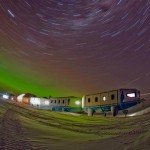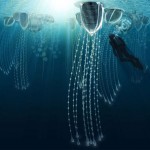 |
In many respects, the Nikon AF-S Nikkor 180-400mm F4E TC1.4 FL ED VR is a dream lens. Earlier this year, with the support of Nikon Europe, I tested it out in some of the harshest conditions on our planet—on a special Polar Bear production in Svalbard, near the north pole.
I took this lens on two different expeditions—first in early April with temperatures reaching well below -20°C with wonderful low-light, and the second expedition at the end of April with the midnight sun and higher contrast. As a professional wildlife photographer, I have to trust my gear to perform and deliver the sharpest images possible, and while this lens took a beating (sorry Nikon) it survived the freezing temperatures and functioned perfectly while providing razor sharp results.
 |
| Nikon D850, Nikon 180-400mm F4 @ 250mm (No TC) F4.5 1/800sec ISO 80 |
Construction and Handling
This lens is part of the new generation of E lenses with reduced weight compared to older designs. That’s important, since it makes hand-held shooting a lot easier. The entire body of the lens feels firm and well-balanced, although it’s a bit front-heavy in my opinion.
Compared to the much-loved Nikon 200-400mm, the new lens weighs less, and is in fact even lighter than the Nikon 300mm F2.8. The wide zoom ring and focus ring, plus the TC lever, make it easy to manipulate even when wearing the thick gloves required at this latitude, in temperatures well below freezing.
During my shooting, this lens “ate” a lot of snow and wind, and survived being transported for hundreds of kilometers on my snowmobile with nary a complaint.
 |
| Nikon D850, Nikon 180-400mm F4 @ 195mm (No TC) F4.5 1/2000sec ISO 80 |
Zoom Range
Without the 1.4X teleconverter engaged, the 180-400mm has wonderful range and the advantage of a constant F4 aperture. Going from one zoom extreme to the other requires only a 1/4 turn of the zoom ring, which is much quicker than the Nikon 200-500mm.
However, while 180-400mm is a usable range for large mammals or medium-sized ones that allow the photographer to approach relatively closely, its not long enough for safety if you want to capture a tight portrait of a predator like a polar bear. For that extra reach, Nikon has integrated a 1.4X teleconverter, which turns the 180-400mm into a 250-550mm lens at the cost of one f-stop—making it an F5.6 constant aperture zoom.
 |
| Nikon D850, Nikon 180-400mm F4 @ 210mm (No TC) F4.5 1/500sec ISO 80 |
Focus
As you might hope from a lens of this type (and price) autofocus is blazing fast. It feels faster than the old 200-400, and also faster than the Nikon 600mm F4. I didn’t notice any hesitation or ‘hunting’ during focusing.
Aperture, Vignetting and Sharpness
Image quality at F4 is really great—not only usable but actually really sharp throughout the zoom range. My Nikon D850 was pushed to its resolution limit even with the widest aperture selected. When engaging the TC, the lens does get a bit softer, and there is very noticeable vignetting wide-open; the converter is there if you need it, but I’d recommend engaging it only when absolutely necessary.
 |
 |
Nikon D850, Nikon 180-400mm F4 @ 550mm (TC) F5.6 1/320sec ISO 80
100% crop (click to view) |
Overall, the images came out crisp, sharp and with excellent contrast—even when shooting backlit subjects. I saw no flare, no ghosting and no noticeable chromatic aberrations.
Vibration Reduction
This lens features Nikon’s new-generation VR system, which is good for around 4.5 stops of correction. During my shooting, VR was very useful for hand-held shots.
Price and Value
The sadistic part of my personality enjoys looking in people’s eyes when they get all excited about the lens and ask me how much it costs. When I say $ 12,000 USD, the bright light of childish enthusiasm is quickly extinguished.
It’s a lot of money, but as the expression goes: “you get what you pay for.”
This is a dream lens with so many advantages, both optically and in terms of handling, and that comes at a cost. The cheaper and more approachable option would be the Nikon 200-500 F5.6, which costs a mere $ 1,500. As a friend of mine said, “I could buy eight of those for the price of one 180-400 F4.” I don’t know what he would do with eight lenses, but you get the point.
 |
| Nikon D850, Nikon 180-400mm F4 @ 250mm (No TC) F4.5 1/800sec ISO 80 |
Final Thoughts
So the 180-400mm is a dream lens, but the dream doesn’t come cheap. For a safari in Africa, a project in Svalbard or any action-packed wildlife shooting it’s perfect. In sports or any activity where the subject is moving in your direction, this lens could be a great option. For capturing birds, small mammals or any subject where you know you’d end up cropping after the fact, I’d tend to go for a long telephoto prime instead.
So… is it worth it? That depends on your standards, requirements and the depth of your pockets. The 180-400 lets in an extra stop of light compared to the 200-500mm and offers much better sharpness, faster focus and better handling, not to mention the ability to reach 550mm with the flip of my thumb. I’d go for the 180-400mm without hesitating.
If your budget is tight and you can’t afford this lens, the Nikon 200-500mm F5.6 is a very attractive option, but it can’t match the 180-400mm for speed, critical sharpness or versatility.
About the Author: Roie Galitz is an award-winning wildlife photographer. He travels in extreme conditions to the remotest places on earth, from the Arctic right down to Antarctica, capturing images of rarely viewed animals in their natural habitats. He is a sought-after public speaker, a photography expedition leader and a proud ambassador of Nikon Israel, Global DJI and Greenpeace.
You are welcome to see more of his work and bio on his website and follow on Instagram and Facebook.
Roie Galitz was not compensated for this article in any way either by Nikon or DPReview, and Nikon had no involvement in its publication.
Articles: Digital Photography Review (dpreview.com)





















You must be logged in to post a comment.